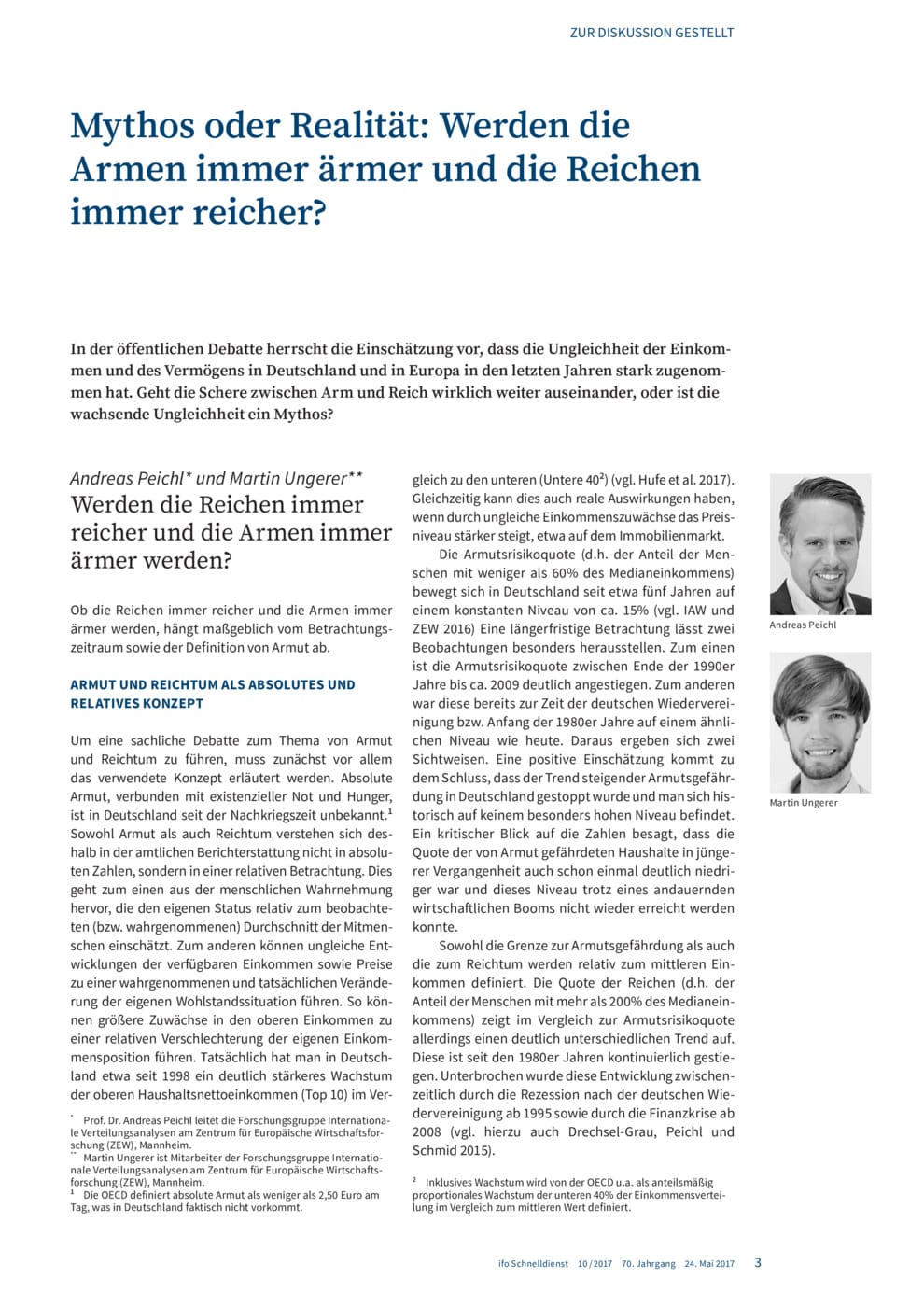Myth or Reality: Are the Poor Getting Poorer and the Rich Richer?
ifo Institut, München, 2017
ifo Schnelldienst, 2017, 70, Nr. 10, 03-26

In the public discussion, the assumption prevails that the inequality of income and wealth in Germany and Europe has increased strongly in recent years. Is the gap between the rich and the poor truly widening, or is growing inequality a myth? According to Andreas Peichl and Martin Ungerer, Center for European Economic Research (ZEW), Mannheim, the poor are not necessarily poorer, but the rich are indeed getting richer. In addition, there have been negative developments in the past with regard to persistent poverty and income inequality that have not been offset by the current employment boom. Nevertheless, taking on a job with suitable advancement opportunities with pay below the poverty-risk rate could make good sense. For this principle to work, however, government incentives to take on employment, especially for low-income earners, should be improved. According to Richard Hauser, Goethe University Frankfurt, between 15.5 and 16.5 percent of the population are currently at risk of income poverty. An increase in inequality is evident in many highly developed countries as well as on average for EU countries, with the German poverty risk still slightly below the EU average. For Stefan Sell, Koblenz University of Applied Sciences, the focus on the 10 to 15 percent of low-income people according to the official demarcation is counterproductive as it narrows the discussion that needs to take place. We are confronted much more with a polarisation according to a ”60-40” pattern: 60 percent of people are better off, they have experienced an increase in income and also benefit from the labour market-driven wage development; 40 percent have been left behind, however, and have less disposable income than they had 10 or 20 years ago, even though many of them are fully integrated into the labour market. Judith Niehues and Christoph Schröder, Institute of the German Economy in Cologne, point out that although social inequality is higher than in the 1990s, the income gap has not further widened in the last decade. This is contrary to the widespread presumption that the Agenda-2010 reforms and, in particular, the introduction of Hartz IV are the cause of the rise in inequality. Moreover, poverty measurements, which reflect the diversity of living conditions and are not just income-based, have been showing declining trends in recent years. Instead of only looking at relative income poverty, factors such as employment, material deprivation, education, environment and health should be taken into consideration. Dorothee Spannagel and Anita Tiefensee, Economic and Social Sciences Institute (WSI), note that income inequality has risen despite the economic upturn. Overall, business and investment income has grown more strongly than employee compensation since the beginning of the 1990s. The uneven distribution of disposable household income, as measured by the Gini coefficient, has also increased strongly since the beginning of the 1990s. Helmut Dedy, Deutscher Städtetag (German local government association), stresses that “poverty” should not be equated with “poverty risk”. The latter is merely an indicator for measuring relative income poverty. To gain a true picture of income and wealth distribution and equal opportunity in Germany, a number of indicators must be examined. A strengthening of municipalities and their infrastructure is also an important contribution to the fight to reduce poverty. For Gerhard Bosch and Thorsten Kalina, University of Duisburg-Essen, an all-clear signal is not justified. Inequality continues to increase and its level is not acceptable. The hollowing-out of the middle class also continues. To be sure, the inequality of market income increased more before the Hartz reforms than afterwards, but despite halving unemployment and strong employment growth, the middle class also lost ground after 2004.